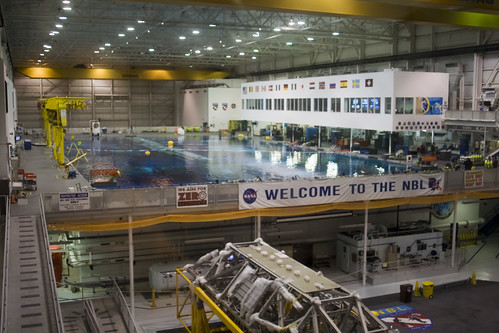
Space Shuttle Endeavour’s current mission, STS-130 (wikipedia), delivered and assisted in assembling the final International Space Station module, Tranquility Node 3/Cupola. There are only four additional Space Shuttle flights until the fleet of remaining orbiters – Endeavour, Discovery and Atlantis – will be permanently retired. Thus ending the era of reusable manned space flight.
Station will continue to be serviced from Russia through the use of Soyuz and Progress, and by the Euopean Automated Transfer Vehicle. These are single-use rockets and remote controlled supply platforms, which will ferry both humans and material to Station.
President Obama recently unveiled his FY2011 budget outlining, with little surprise, the reduction of funding for any manned mission to Luna or Mars:
US space agency Nasa has already spent $9bn (£5.6bn) on the programme.
The president said Constellation was draining resources from other US space agency activities. He plans instead to turn to the private sector for launch services.
“While we’re cancelling Constellation, we’re not cancelling our ambitions,” said Jim Kohlenberger, chief of staff at the White House Office of Science and Technology Policy (OSTP).
“This isn’t a step backwards. I think the step backwards was trying to recreate the Moon landings of 40 years ago using largely yesterday’s technology, instead of game-changing new technology that can take us further, faster and more affordably into space.”
The decision to cancel Constellation was immediately condemned by Congressional figures who represent workforces dependent on the programme.
This is unsurprising, due to the fact that the Bush Administration’s lofty goal of manned missions to Luna and Mars lacked an essential item: any real funding whatsoever. Any future manned flights will come from private or public-private joint ventures.
The era of the Moonshot is over.
While the budget is pragmatic – especially in the current political environment – this is unfortunate. Humans are still stranded on a single blue planet, which we continue to neglect. Global Warming and climate change is real, and the probability of major climate events negatively affecting the population is growing. Colonizing other planets, while wonders of science fiction, increases our survival chances. Until there is a major trigger (Chinese settle Luna?), I don’t see manned space flight being anywhere near a priority of the USA in the near future.
This is also unfortunate since once we disband Project Constellation and Orion platforms, the professionals developing those programs will be scattered to the wind. With funding also goes facilities, such as the Space Vehicle Mockup Facility where NASA continues to develop the Orion module today.
When I was at NASA’s Johnson Space Center, it was mentioned more than once that Constellation and Orion was to defunded during FY2011, but there was never any plea for us to apply pressure to our Congresspeople. Rather it was plain that they were professionals, yet disappointed that these programs could end. One NASA engineer commented that they hope it is decided one way or another to fund or defund so they could plan out the rest of the fiscal year: either to push ahead with continued mockups, testing and design or reach an agreed upon fidelity, then wrap up the program in a way which the learnings and technology could be handed off to a third party.
If you have an opinion, please contact your Member of Congress.

This article continues my reporting of my junket NASAtweetup at the Johnson Space Center on 17 FEB 2010. For all articles, check out the NASA tweetup page and photos.


















